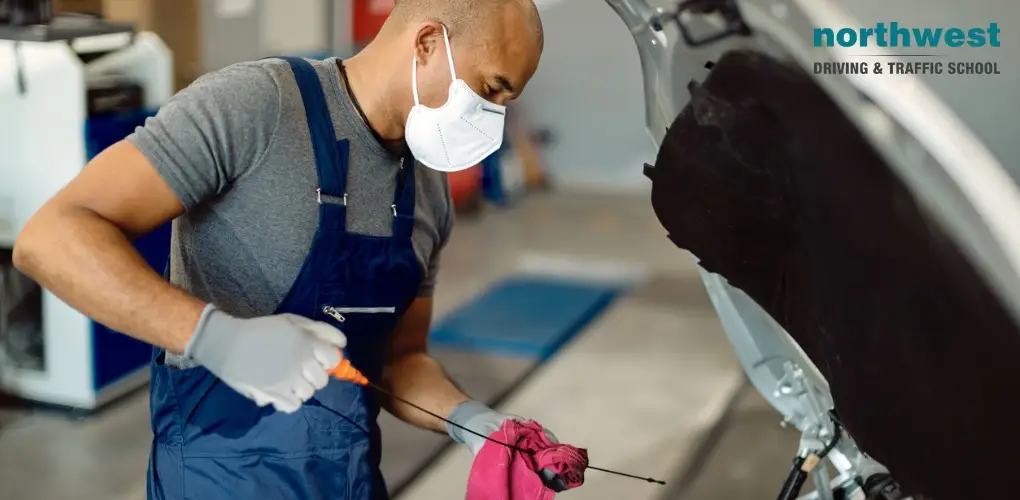- Others
Basic Car Maintenance: What Can You Do Yourself?

It’s important to keep your car in good driving condition. This can be done by performing basic maintenance and driving responsibly.
You can do many things yourself, such as checking tire pressure, filling up the gas tank, or changing a flat tire.
If you have more time on your hands, you can complete plenty of other tasks before handing over your car for repairs when it breaks down on the side of the road.
In this article, we’ll cover what simple car maintenance basics you can undertake that will stop you from needing to take an expensive trip to a mechanic.
Read More: Basic Car Maintenance For New Drivers- Part One
Table of Contents
How To Maintain Your Tires
The tires on your car are one of the most important driving components, yet people neglect their maintenance. Driving in a city with heavy traffic and frequent stops can cause wear to the treads on your tire quickly.
To maintain proper tire pressure, you can purchase an air compressor with a gauge built-in. This will allow you to quickly and assess your tire pressure.
You should also regularly check your front and rear tire pressure by checking the sidewall of each tire to see what air pressure is recommended for driving in those conditions and then ensure that both front and rear tires match this number on either side.
This will save wear and tear on one set and help you get the longest life from your tires.
Underinflated tires also do not handle as well in a variety of driving conditions, such as rain and snow, and increase the drag on the road, costing you money.
It’s also worth investing in a tire tread depth gauge. The tread on a tire wears away over time and, depending on the state you are in, if they are below a certain depth, you could face a fine.
Oil And Coolant Levels
Most people are aware that petrol is something that needs replacing on a regular basis but often forget about their oil and engine coolant levels.
If oil levels are low, the engine risks overheating and can sustain damage to some parts, which can be expensive to fix.
The oil should be replaced every 5000 kilometers or once per year.
Engine coolant works as a coolant and antifreeze, driving off the heat produced by your car’s engine. It also helps to prevent rust from forming inside your engine.
If it gets too low, this can cause serious problems with overheating and even freezing in cold weather conditions.
The coolant should be replaced every two years.
The other thing that’s easily forgotten is the windscreen washer fluid – keeping this topped up should help you see well in bad weather conditions.
Check Your Windscreen Wipers
Windscreen wipers are often overlooked for maintenance since you don’t need them until it starts to rain.
If the rubber on your wipers starts to crack or peel away, it can be really difficult to see when driving in wet conditions.
You might want to consider changing them before winter as the cold weather conditions can cause wipers that are already damaged to deteriorate rapidly.
Make Sure Your Lights Are Working
Making sure your lights are working is, for hopefully obvious reasons, hugely important
If you are driving in the dark and one of your lights isn’t working, it can be dangerous for you and other road users.
While driving at night might not always feel like a big priority, changing any blown bulbs promptly is important to maintaining road safety.
Pay special attention to your full beam, fog, and rear lights, as they are either harder to see or infrequently used and can burn out without you noticing.
Regularly Check Your Battery
Nothing will ruin your day like a flat car battery!
Tests can be done with a voltmeter, which you should have in your car if it has been driving for more than six months.
If the battery isn’t holding charge anymore and needs replacing, ensure it is disposed of correctly by taking it to an authorized dealer or recycling station (local authorities will know where these are).
If you are planning on taking your car off the road for a long period of time, you can maintain your battery by connecting it to a solar trickle charger.
If you are driving to a specific place for a long period of time, make sure the car is running at least an hour before leaving (or longer if possible) so that your battery doesn’t run flat when you’re driving on the highway!
Also, keep in mind that sitting with headlights and wipers on will drain your battery at a faster rate.
Replacing Your Brake Pads
It’s important to make sure that your brake pads are in good condition, as driving with worn-down brake pads can be very dangerous.
How long will a set of car brakes last?
It really depends on the quality and style of your new brakes – but you should expect around 50-60 thousand kilometers before needing to change them again! If you’re driving an older car, you may need to change your brake pads more frequently.
Is There Anything Else I Should Be Thinking About?
In addition to these basic maintenance checks, always pay attention to any warning lights you see on your dash and address them as soon as possible.


